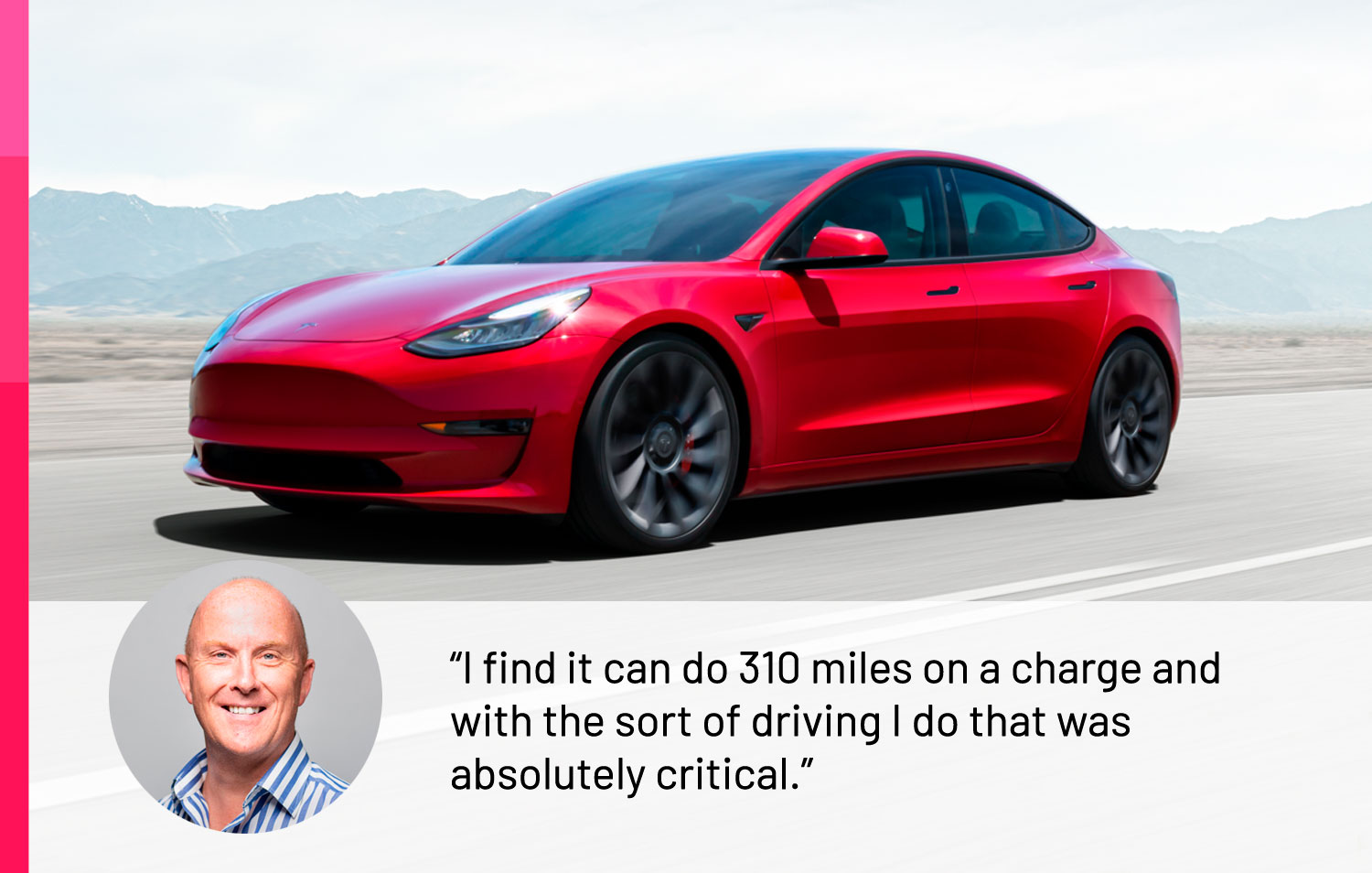S h a r e
Choosing an EV – when you drive lots of miles for your job


Posted by
The EV Team
August 2023
Electric cars and high mileages might not seem an ideal match. Drivers regularly covering long trips, particularly along the UK’s motorway network, have traditionally steered away from pure-electric models.
But that’s no longer the case as the technology behind EVs has improved immeasurably.
Of course suitability depends on journey type, not just journey length, and how those trips are broken down.
For example, if you cover a really high mileage, say 42,000 miles a year – that’s 1,000 business miles a week – then even this would easily suit electric car use with 250-300+ miles a day, allowing for three-to-four days travel and one or two working from home.
Split this way, an electric car could easily suit a working brief, with many EVs capable of covering more than 250 real-world miles on a single charge. Here, we’ve listed all the models capable of covering 300 miles or more, according to official WLTP figures:
- Mercedes Benz EQS – 452 miles
- Fisker Ocean – 439 miles
- Volkswagen ID.7 – 435 miles
- Polestar 2 – 406 miles
- Tesla Model S – 403 miles
- Mercedes-Benz EQE – 397 miles
- BMW iX – 391 miles
- Mercedes-Benz EQS SUV – 383 miles
- Hyundai Ioniq 6 – 382 miles
- Tesla Model 3 – 382 miles
- BMW i7 – 380 miles
- Polestar 3 – 379 miles
- Audi Q8 e-tron – 373 miles
- Ford Mustang Mach-E – 373 miles
- Lotus Eletre – 373 miles
- BMW i4 – 366 miles
- Volvo EX90 – 364 miles
- BMW i5 – 362 miles
- Skoda Enyaq iV – 348 miles
- Volkswagen ID.3 – 347 miles
- Cupra Born – 342 miles
- Volvo C40 – 341 miles
- Mercedes-Benz EQE SUV – 340 miles
- Volkswagen ID.5 – 338 miles
- Tesla Model X – 337 miles
- Kia EV9 – 336 miles
- Nissan Ariya – 333 miles
- Volvo XC40 – 332 miles
- Volkswagen ID.4 – 331 miles
- Mercedes-Benz EQA – 330 miles
- Kia EV6 – 328 miles
- Genesis G80 Electrified – 323 miles
- Rolls Royce Spectre – 323 miles
- Genesis GV60 – 321 miles
- Hyundai Kona Electric – 319 miles
- Tesla Model Y – 319 miles
- Audi Q4 e-tron – 316 miles
- Hyundai Ioniq 5 – 315 miles
- Porsche Taycan – 314 miles
What if the range is not enough?
It’s best practice in any car to stop after two hours at the wheel, otherwise safety-compromising fatigue can set in. And a quick break is a perfect opportunity to recharge both you and your vehicle’s battery.
Either using your car’s onboard navigation system, which can direct you to suitable charging stopovers on your journey, or EV charger mapping resources such as Zap-Map, you can plan a journey break that can include a charge up of your car’s battery.
Rapid and ultra-rapid chargers can top up the battery very quickly – a 20-minute charge can give you up to 80% capacity. Tesla drivers also have access to the full Tesla Supercharger network, but even that is being gradually opened up to drivers of other car makes.
All motorway services have a selection of rapid chargers available for EV drivers to use, and these are being upgraded across the UK to increase units as EV numbers grow too. These services are being complemented by EV charging hubs close to main routes, which boast large numbers of high power chargers.
What about charging at home?
We would advise all higher mileage drivers to have access to a home charger – it can work without, but if your job is to drive the miles, you really will need a home charger to make EV life efficient, so that when you get home at the end of the day, the car can be plugged in and ready for you the next morning. (See our section Ordering a home charger.)
How long will it take to charge my car overnight?
We would recommend that at home you have a 7kW home charger fitted. This will charge 3x faster than a domestic three-pin socket.
For a broad idea of how quickly your battery will be charged, you divide the capacity of your battery by the output of your charger. We’ve taken some of the long-range EVs from our list above to provide you with a guide to how quickly they will take to charge overnight from zero to 100% and the cost (calculated at 34p per kWh, the UK average electricity unit cost).
There are two things to note. Firstly, these are maximum times – from 0-100% – but very rarely will a driver get to single figures in battery percent before charging, and many charge from around 20%, so charging times will usually be a lot shorter. It’s also worth knowing that there are off-peak EV-tailored home energy tariffs available, which can bring pence per unit prices to as low as 7.5p/kWh, which could considerably reduce charging costs.
- Mercedes Benz EQS – 452 miles – 107.8kWh battery – 15.5 hours – £36.70
- Hyundai Ioniq 6 – 382 miles – 74kWh battery – 10.5 hours – £25.20
- BMW i4 – 366 miles – 80.7kWh battery – 11.5 hours – £27.50
- Volkswagen ID.3 – 347 miles – 77kWh battery – 11 hours – £26.20
- Kia EV9 – 336 miles – 99.8kWh battery – 14.2 hours – £33.90
- Nissan Ariya – 333 miles – 87kWh battery – 12.5 hours – £29.60
- Hyundai Kona Electric – 319 miles – 65.4 kWh – 9.3 hours – £22.20
Source: Go Ultra Low
Make the most of your charge
The majority of EVs have an app linked to the car that allows you to perform functions while the vehicle is still connected to the charger. The most obvious one is heating the car up and defrosting it during winter. The car will do this while still drawing electricity from the mains rather than once you have started and you drain the battery, depleting range.
Some cars also have the ability to pre-condition the battery. This effectively takes the battery to its optimal operating temperature before you drive, which helps extend the vehicle’s range. Plotting in charging stops in certain EVs will see the same pre-conditioning process start while driving as you get close to the charger, reducing waiting times with the fastest possible charge.
BIK advantages
The benefits of an EV for longer distance drivers are the same as they are for drivers that cover fewer miles. But the savings have the potential to be far greater.
If diesels are the high mileage choice, the difference in taxation between a diesel and an EV is extraordinary. With BIK rates frozen at the lowest 2% until April 2025, a 40% tax paying driver in a Polestar 2 Long Range Single Motor EV will pay £1,369 in tax over the full three years. The equivalent, using the closely-related Volvo brand and its diesel XC60 with a similar OTR price, will cost the same driver £23,199.
This is why it makes sense to understand your journey needs and try to make an EV work for your business requirements. For today’s long-distance business drivers, it’s easier than ever before.
Case study

Rob Wentworth-James
- Drives a Tesla Model 3
- High mileage driver
- Uses home charger
Not so long ago, a high mileage fleet driver would be pointed automatically in the direction of a diesel.
But that knee-jerk reaction to executives ‘out on the road’ is changing. And changing as rapidly the lengthening ranges of electric cars.
Rob Wentworth-James is the corporate sales director at Fleet Alliance and averages 20,000 miles a year, of which 13,000 are business-related. While most of Rob’s journeys are fairly short, they are interspersed with much longer drives to meet clients on business, or family at the weekends.
“There was no question that my choice had to be the Tesla Model 3 Long Range model,” explains Rob. “I find it can do 310 miles on a charge and with the sort of driving I do that was absolutely critical. The other reason for my choice was financial – the zero benefit in kind means I now have extra retained income in my account each month.”
The availability of Tesla Superchargers on motorways was another essential factor in Rob’s choice, particularly as they are exclusive to Tesla drivers.
“I have used the rapid chargers several times,” explains Rob. “You can be in and out in 25 minutes and I’ve never yet been held up waiting for other Tesla drivers to finish charging. It couldn’t be more perfect!”
As you may gather, Rob is something of an EV convert, describing it all as a “fabulous experience”. But what advice would Rob offer to other high mileage drivers considering an EV?
“I would say that driving electric is no different from driving any other petrol or diesel car, other than you have to plan your journey a little better. And for journeys over 250 miles, I’d be seriously considering going by train, so I could work. But that would be the case if I was in a petrol or diesel car, simply because it is a more productive use of your time. At least in my experience, I see no reason why a high mileage driver shouldn’t choose an electric car.”

